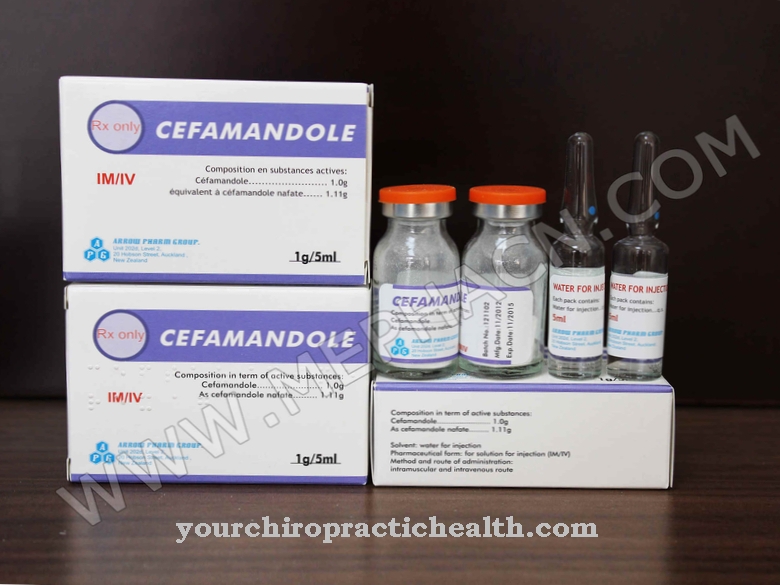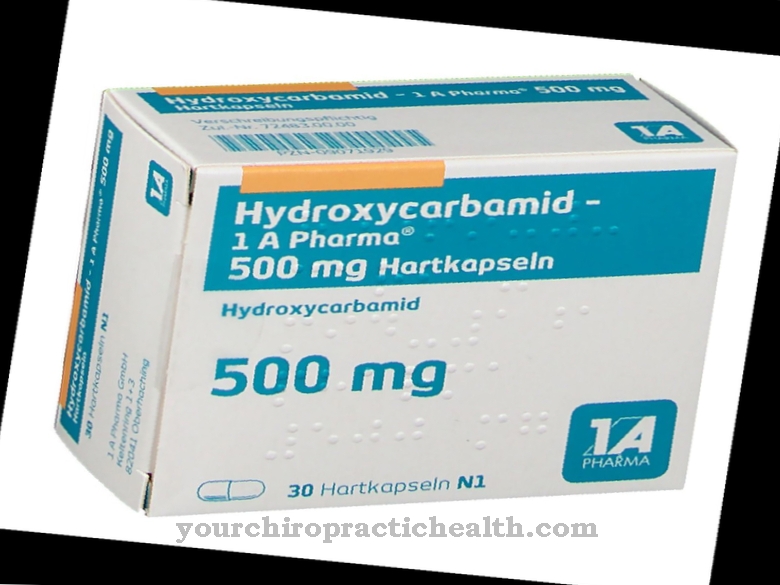Doxorubicin is a drug from the group of anthracyclines, which are used in chemotherapy as cytostatics to treat various types of cancer. The active ingredient belongs to the intercalants.
What is doxorubicin?
Doxorubicin is a cytostatic drug. Cytostatics are substances that inhibit cell division and / or cell growth. They are therefore mainly used for the treatment of cancer or autoimmune diseases.
Doxorubicin is a so-called hydroxy derivative of the natural antibiotic daunorubicin, which is produced by the bacteria Streptomyces peuceticus and Streptomyces coeruleorubidus.
Since the effect of the cytostatics is based on the storage of molecules in the DNA (intercalation), doxorubicin is assigned to the intercalants. The substance is administered to the body intravenously or intraarterially, i.e. via an infusion or injection, for the treatment of tumors such as breast carcinoma or bronchial carcinoma.
Pharmacological effect
Doxorubicin binds to the DNA of the body cells and prevents the polymerases from binding, which in turn are used to copy the genetic material. As a result of this disruption, the active ingredient blocks both the synthesis of DNA and the synthesis of RNA, thereby inhibiting cell division and ultimately causing cell death.
In particular, the body cells in the S phase are very sensitive to the substance. The S-phase is the replication phase of the cell cycle, in which the new DNA synthesis takes place. Since tumor cells divide more frequently, they are significantly more often affected by the toxic effects of the drug than healthy body cells.
Medical application & use
Doxorubicin has a very low rate of resistant tumors and is therefore used together with other intercalants in almost all solid tumors. These include, for example, cancer of the female breast or the bronchial system. Lymphomas are also typical indications for doxorubicin. Doxorubicin is also suitable as a monotherapy for patients who cannot tolerate a highly effective combined chemotherapy.
In the case of simpler tumor diseases, the agent is administered intravenously, i.e. into a vein. In contrast, hepatocellular carcinoma (HCC), a malignant cancer of the liver cells, requires intra-arterial application as part of a transarterial chemoembolization (TACE). The treatment takes place here via a special catheter system through the arteries. In this way, the active substance can be applied directly into the vessels that supply the tumor.
Chemotherapeutic agents such as doxorubicin are temporarily embolized with iodine-containing oils or starch particles in order to prolong the effectiveness of the therapeutic agents in the tumor. The embolization agents reduce the blood supply to the tumor and the chemotherapeutic agent remains in the cancerous growth longer.
You can find your medication here
➔ Medicines for relaxation and nerve strengtheningRisks & side effects
One of the most significant side effects is bone marrow depression. Here normal blood formation in the bone marrow, the so-called hematopoiesis, stops. This leads to a shortage of red and white blood cells and platelets. As a result, the immune system is significantly weakened, so that those affected more often suffer from infections.
Thrombocytopenia, the lack of blood platelets, increases the risk of bleeding. Patients can develop severe bleeding even with minor injuries.
Typical symptoms of anemia are decreased performance and rapid fatigue. Any bone marrow depression is potentially life threatening.
Doxorubicin can have both nephrotoxic and cardiotoxic effects. Nephrotoxins damage the kidney cells and can cause glomerulonephritis. In this bilateral form of kidney inflammation, the kidney corpuscles are affected first. Glomerulonephritis is one of the most common causes of chronic kidney failure.
Cardiotoxic agents, on the other hand, damage the heart muscle. This can lead to cardiomyopathy. Such a doxorubicin-induced cardiomyopathy can be counteracted months after the first administration with the administration of dexrazoxane. This active ingredient can reduce the cytotoxic effects of doxorubicin.
Ulceration is also one of the potential side effects of doxorubicin. The deep-lying substance defects of the skin or the mucous membrane are also known as ulcers.A scarless healing of these painful skin symptoms is not possible. In the worst case, severely affected extremities have to be amputated.
Open wound infections are also a potential complication.












.jpg)



.jpg)










.jpg)
